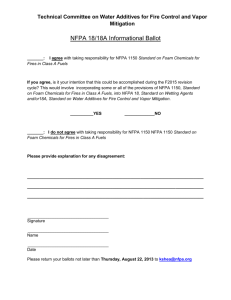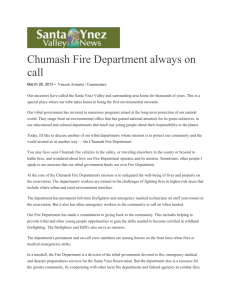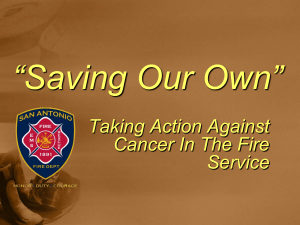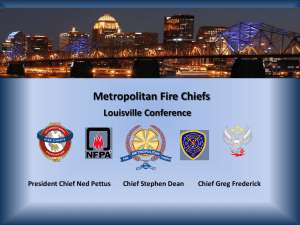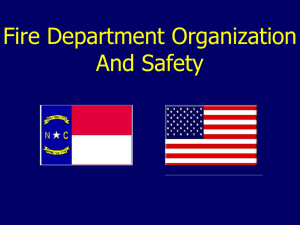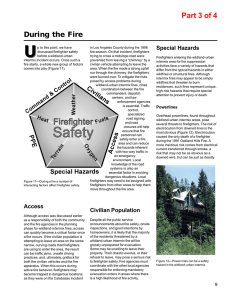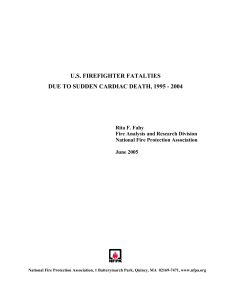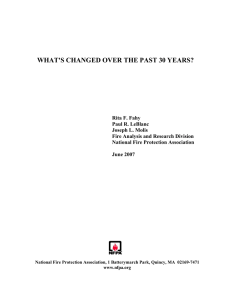Document
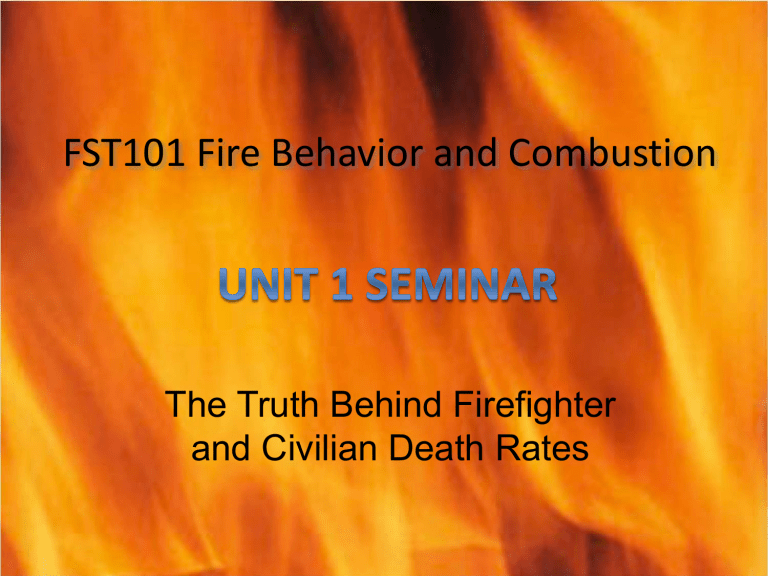
FST101 Fire Behavior and Combustion
The Truth Behind Firefighter and Civilian Death Rates
Unit 1 Objectives
Review course administrative and information requirements
Discuss the sources for fire fatality statistics and information
Discuss what may be causing the increase or decrease in fatalities
What does the fire protection community need to do to reverse or slow the trend?
Course Information
FS101-01 – Fire Behavior and Combustion
Weekly Seminar – Thur. 9:00 pm EST
AIM – Messenger
○ User name – emorgenthaler156
○ Office Hours: Monday, 6:45 pm – 7:45 pm
○ Or any time by appointment as needed
Email me anytime if you have a question or something comes up!
Fire Dynamics
• The detailed study of how chemistry, fire science, and the engineering disciplines of fluid mechanics and heat transfer interact to influence fire behavior. NFPA 921 Guide for Fire and Explosion Investigations, 2008
Edition
5
Course Description
This course investigates the basic concepts of fire, its spread, and its control. The course discusses the nature and properties of the three states of matter, explains the components of fire, and describes the physical and chemical properties of fire.
6
Course Objectives
FS101-1: Explain how motivating factors of modern fire research impact fire science
FS101-2: Explain heat flux and its implications in the danger of fire heat transfer
FS101-3: Identify types of fire spread
FS101-4: Interpret the factors that have an effect on the energy release rate
FS101-5: Describe the role fire gases play in the development and spread of fire
GEL-1.1: Demonstrate college-level communication through the composition of original materials in Standard
American English
GEL 8.1: Apply critical thinking to construct persuasive arguments
Course Expectations
Have Fun and Enjoy this Experience
Don’t let worrying get in the way of learning
Syllabus
Course
Announcements
Weekly Seminar
Notify me if you cannot make it
Course Expectations (con’t)
Discussion Boards
Respond to Question and to Students
○ MINIMUM of 2 posts
1 Original response to the questions
At least 1 response to another student
This is where the course learning really takes place, the interaction on the boards and group discussion.
Review the Grading Rubrics in the Course Syllabus
Timeliness & Frequency
Breadth and Depth of Responses
Clarity, Organization, Grammar, Mechanics
Course Expectations (con’t)
Assignments
Spell Check and Grammar Check
Writing Center
Readings and PowerPoint Slides
Communicate with me, I am here for your success!
APA Expectations Slide Here
Seminars
Thursday, 9:00 pm EST
You must be an active participant for full credit,
25 points
Make up option available
Audio delay, 30-45 seconds
Wonderful opportunity to learn and share information
Introduction
What events have brought the profession to the forefront?
Do we have to lose
Firefighters?
“In the chaos of what turned out to be a false report of people trapped inside a burning Genesee Street deli in the early morning of Aug. 24, a cry of "mayday" rang out from a firefighter's portable radio.” The Buffalo News
Sources for fire fatality information
Sources for fire fatality information (con’t)
Common sources for statistical information are:
Impact of fire in the US
http://www.usfa.dhs.gov/statistics/quickstats/ index.shtm
US Fire Statistics
http://www.usfa.dhs.gov/statistics/
National Fire Protection Association
www.nfpa.org
How do we stack up?
How does the US stack up to Britain?
Let’s look at:
○ Total fires
○ Civilian fire deaths
○ Firefighter deaths
US vs Britain
US 2007
3,430 civilians deaths
118 firefighters killed
1.6 million fires
Britain 2006
491 civilian deaths
2 firefighters killed
426,200 fires http://www.communities.gov.uk/documents/fire/pdf/firest ats2006.pdf
Why are we so different?
Population
Building Codes
Attitudes towards fire
Culture of our fire service
Are civilian fatalities going up or down in the US?
Are we going to more or fewer fires?
According to the NFPA report found at http://www.nfpa.org/assets/files//PDF/FireLossabstract.pdf
states:
“The US Census the resident population grew
37% from 1977 to 2007. Figure 2 shows that the rate of fires per 1,000 population fell 65% from
14.9 in 1977 to 5.2 in 2007.”
So yes fires are down! But……
Since fires are down are we losing more or less firefighters?
We are losing more, fires are down but we still on average lose a 100 firefighters a year in the US.
The Firefighter Deaths in 2007 Compared to 2006, 1997, 1987 and 1977
2007 2006
102
35%
Up 15%
1997 1987 1977
Up 3% Down 23% Down http://www.nfpa.org/assets/files//PDF/FireLossabstract.pdf
What do we need to do?
Codes
Standards
Education (ourselves and public)
Training
To Do...
Introduce Yourselves
○ Nickname
○ City and State
○ Why are taking this class
○ Prior knowledge / experience
○ Educational goals
○ How is this class going to help
○ What is your AIM name
Respond to Another
Student
To Do...
Review Key Terms (reading page)
Read eTextbook Preface
Visit Extra! Extra!
Review Reports (USFA)
Respond to Discussion Board
What do you hope to learn in this class?
Most Importantly…Have a Great
Experience and Continue Long-
Learning!



